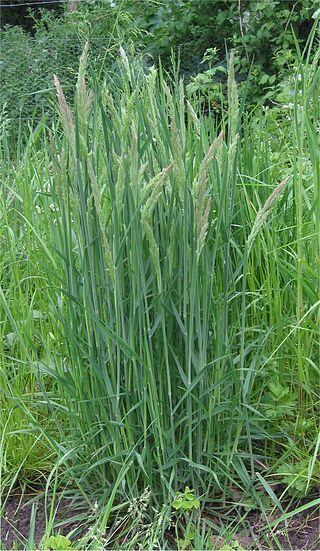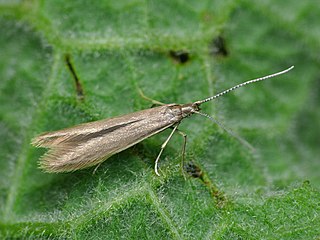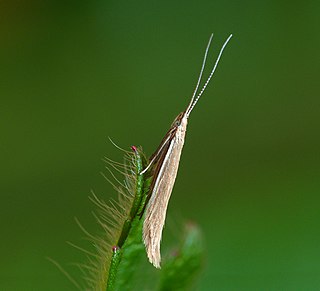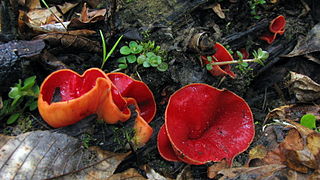
Juncaceae is a family of flowering plants, commonly known as the rush family. It consists of 8 genera and about 464 known species of slow-growing, rhizomatous, herbaceous monocotyledonous plants that may superficially resemble grasses and sedges. They often grow on infertile soils in a wide range of moisture conditions. The best-known and largest genus is Juncus. Most of the Juncus species grow exclusively in wetland habitats. A few rushes, such as Juncus bufonius are annuals, but most are perennials.

Juncus is a genus of monocotyledonous flowering plants, commonly known as rushes. It is the largest genus in the family Juncaceae, containing around 300 species.

Juncus effusus is a perennial herbaceous flowering plant species in the rush family Juncaceae, with the common names common rush or soft rush. In North America, the common name soft rush also refers to Juncus interior.

Holcus lanatus is a perennial flowering plant in the grass family Poaceae. The specific epithet lanatus is Latin for 'woolly' which describes the plant's hairy texture. Common names include Yorkshire fog, tufted grass, and meadow soft grass. In North America, where it is an invasive species, names include velvet grass and common velvet grass.

Juncus bufonius, known commonly as toad rush, is a widespread flowering plant species complex in the rush family Juncaceae.

Juncus articulatus is a flowering plant species in the rush family Juncaceae. It is known by the common name jointleaf rush or jointed rush, which can also refer to J. kraussii from Australia. It is native to Eurasia, Canada, Greenland, and much of the United States. It grows in moist areas, such as wet sand, and thrives in calcareous soils. J. articulatus was found to be more sensitive to drought and salt stress than its congeners J. acutus and J. maritimus. It is a perennial herb producing mainly erect stems from a short rhizome. The stem may root at nodes, and it generally has one or more flattened hollow cylindrical leaves up to 10 centimeters long. Transverse internal partitions or joints may be seen or felt in the leaf of the plant.
Borophagus dudleyi is an extinct species of the genus Borophagus of the subfamily Borophaginae, a group of canids endemic to North America from the late Hemphillian of the Miocene epoch through the Pliocene epoch. Borophagus dudleyi existed for approximately 5.4 million years.

Coleophora caespititiella is a moth of the family Coleophoridae. This species is found throughout the United Kingdom and most of Europe. It is also known from North America. The Coleophoridae group are often collectively known as the case moths or case-bearers.

Juncus gerardii, commonly known as blackgrass, black needle rush or saltmarsh rush, is a flowering plant in the rush family Juncaceae.

Coleophora glaucicolella is a moth of the family Coleophoridae, found in Asia, Europe and North America. It occurs in forest-steppe biotopes, wet meadows and meadow-steppe.

Sarcoscypha austriaca is a saprobic fungus in the family Sarcoscyphaceae of the order Pezizales of Ascomycota. It is commonly known as the scarlet elfcup, pézize écarlate and scharlachroter kelchbecherling. The species name means "from Austria".

Sarcoscypha dudleyi, commonly known as the crimson cup or the scarlet cup, is a species of fungus in the family Sarcoscyphaceae of the order Pezizales. In addition to its main distribution in the central to eastern United States, the fungus has also been recorded once in Bulgaria. It has been frequently confused with Sarcoscypha coccinea, but can be distinguished from this and other related species in Sarcoscypha by differences in microscopic characteristics, such as the presence and number of oil droplets in the spores. The species Molliardiomyces dudleyi is an imperfect form of the fungus that lacks a sexually reproductive stage in its life cycle.

William Russel Dudley was an American botanist. He headed the botany department at Stanford University from 1892 to 1911. His collection built at Stanford is considered to be one of the most important contributions to knowledge of the flora of California. This became the nucleus of what is now known as the Dudley Herbarium.

Juncus marginatus is a species of flowering plant, it is a type of rush with the common names of margined rush and grass-leaf rush.

Juncus bulbosus, the bulbous rush, is a species of flowering plant in the genus Juncus, native to Iceland, the Faroes, Europe, Macaronesia, and northwest Africa. It has been introduced to Australia, New Zealand, and some locations in northern North America. It is capable of nuisance growth in lakes and streams.

Juncus inflexus, the hard rush, is a species of flowering plant in the family Juncaceae, native to Europe, Asia and Africa, and introduced in Sri Lanka, Java, Île Amsterdam and Île Saint-Paul, Victoria in Australia, New Zealand, Uruguay, and eastern North America. It is a glycophyte (non-halophyte).
Juncus biglumis, called the two-flowered rush, is a species of flowering plant in the genus Juncus, native to the subarctic and subalpine Northern Hemisphere. It has three divergent genetic lineages that may represent cryptic species.
Juncus fauriei is a species of flowering plant in the rush family Juncaceae, native to central Korea, central Japan, and the Kuril Islands. A perennial, it is found in wetlands, frequently in sandy soils near the coast. Its chromosome count is 2n = 80.














